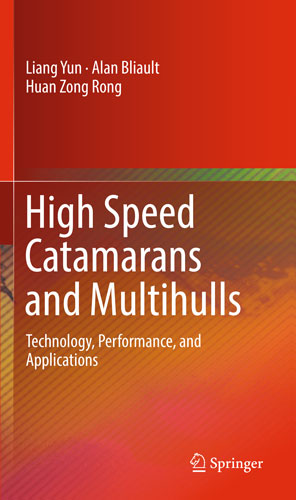High Speed Catamarans and Multihulls/Скоростные катамараны и многокорпусные суда
Издание на английском языке
This book takes a broad view of the multihull concept and its design. We go into some depth on the hydrodynamics of such vessels while also aiming to give the reader an appreciation of what it takes to create a multihull as a project, where the underwater configuration is the starting point. A naval architect or marine engineer will be sensitive to the need to strike a balance between the configuration selection based on service requirement and the consequences of that choice of vessel geometric form for the structure, powering, motions, and total cost of ownership (TCO).
Thus, this is a naval architecture book rather than simply a hydrodynamics text.
For a more detailed treatment of hydrodynamics for such vessels, readers are referred to texts given in the references and listed in the resources section at the back of the book. University libraries should have access to printed or electronic versions. We will refer to subject matter covered in these other resources as we progress, taking a project delivery approach. Nevertheless, we present an overall approach to selecting and analyzing the form of a multihull vessel based on work at MARIC, where two of the authors have dedicated their careers to high-speed marine technology. This work in turn is linked throughout the text to research in Norway, the UK, Australia, and, more recently, the USA and further developed using the major project execution experience of author Bliault.
We will follow a sequence that can be applied when working on a multihull project. The early part involves looking at options based on available statistical data or some fundamental analysis. Once a starting configuration (or range of examples) is established, the design and analysis cycle can start. To achieve an “optimum” result, you need to have your roadmap set up with the key decision points and core design limitations (including your specification for accept/reject decisions). Without such a roadmap, the design/configuration can easily go off on a tangent and result in one parameter being optimized but a vessel that does not meet an operator’s overall requirements. We spend some time discussing these decision points in a project timeline.
This book has evolved a great deal from the early drafts of Profs. Yun and Rong of MARIC. Initial papers were prepared in the early 2000s for the wave-making and wake analysis based on the approach used at MARIC in the 1990s. The work was updated in 2010 by Prof. Yun in preparation for this book with materials for an introduction to concepts including SWATH, wave piercers and hybrids, resistance and stability, seakeeping, and design development. Since that time, Alan Bliault has completed additional chapters regarding propulsion, structural analysis, outfitting, and project execution and updated the earlier material to incorporate the work of researchers and engineers primarily in Australia and the UK so as to reflect, to the extent possible, the global approach to catamaran and multihull design as it stands in the current decade.
Contents
1 Evolution
1.1 Our Subject
1.2 Background
1.3 High-Speed Catamaran Development
1.4 Recent Developments
1.5 Moving On
References
2 Initial Assessment
2.1 Basic Concepts
2.2 Buoyancy, Stability, and Coefficients of Form
2.3 Resistance to Motion
2.4 Key Features of High-Speed Catamarans
2.5 Service Applications: Some Thoughts
2.6 Benefits of Scaling Up
2.7 Hybrid Configuration Options
2.8 Synthesis for Initial Dimensions and Characteristics
References
3 Buoyancy and Stability
3.1 Introduction
3.2 Buoyancy, Centers, and Coefficients of Form
3.3 Static Intact Stability
3.4 Transverse Stability
3.5 Longitudinal Stability
3.6 Damaged Stability
3.7 IMO High-Speed Craft Requirements
3.8 Classification Society Guidelines
3.9 Moving on
References
4 Wave Generation and Resistance
4.1 Introduction
4.2 Basic Equations
4.3 Panel Method
4.4 Thin-Ship Theory
4.5 Numerical Calculation for Wave Resistance
4.6 Wake Wave Calculation for Monohull and Catamaran
4.7 Programs to Calculate Resistance, EHP, and Wake Wave for Monohull and Catamaran
References
5 Calm-Water Resistance
5.1 Introduction to Calm-Water Resistance Data
5.2 Resistance Characteristics and Selection of Demihull Configuration
5.3 Approximate Calculation for Resistance in Deep Water
5.4 Approximate Estimation of Resistance in Shallow Water
5.5 Influence of Hull Parameters on Resistance in Calm Water
5.6 Other Measures for Reducing High-Speed Catamaran Resistance
References
6 Seakeeping
6.1 Introduction
6.2 Multihull Motion Characteristics in Waves
6.3 Differential Equation of Rolling Motion for Catamarans
6.4 Differential Equation for Coupled Pitching and Heaving Motion
6.5 Differential Equation of Longitudinal Motion in Waves
6.6 Measures for Improving Catamaran Seakeeping Qualities
6.7 Motion Characteristics of Catamaran Forms in Oblique Seas
6.8 Motion Characteristics in Following Seas
References
7 Principal Dimensions and Design
7.1 Introduction
7.2 Design Characteristics and Limitations
7.3 Use of Statistical Data to Evaluate Principal Dimensions
7.4 Further Considerations for Principal Dimensions and Form
7.5 Considerations for Vessel General Arrangement
7.6 Update of Principal Dimensions
7.7 Wave Resistance Calculation Compared to Model Tests
7.8 Evaluation of Wave Wake
7.9 Small Catamarans – All Speed Ranges
7.10 Moving on from the Hydrodynamic Form
References
8 Wave-Piercing Vessels
8.1 Introduction
8.2 Features of Wave-Piercing Vessels
8.3 WPC Development
8.4 Comparison with Other High-Speed Craft
8.5 Investigation of Wave-Piercing ACC
8.6 Comparison of Calculation and Model Tests for WPC
References
9 Small-Waterplane-Area Twin-Hull Vessels
9.1 SWATH Evolution
9.2 SWATH Characteristics and Limitations
9.3 SWATH Applications
9.4 SWATH Performance
9.5 Wave Resistance from Calculation and Model Testing
9.6 Fast Displacement Catamarans
9.7 Patrol Vessels and Wind Farm Service Craft
References
10 Other High-Speed Multihull Craft
10.1 Introduction
10.2 Planing Catamaran and Tunnel Planing Catamaran
10.3 Super Slender Twin-Hull Vessels
10.4 Fast Trimarans
10.5 Triple Planing Hull
10.6 Pentamaran
10.7 Hydrofoil-Supported Planing Catamaran
10.8 Air Cavity Catamaran
10.9 Concept Review and Selection
References
11 Propulsion and Appendages
11.1 Introduction
11.2 Propellers
11.3 Waterjets
11.4 Main Engines and Drive Trains
11.5 Directional Control
11.6 Trim Control: Stern Flaps and Interrupters
11.7 Motion Control: Stabilizer and Motion Damping Systems
11.8 IMO Guidelines: (IMO HSC Code Chap. 9) Requirements
11.9 Concluding Remarks
References
12 Structure Design
12.1 Introduction
12.2 Structural Concept Issues for Multihull Craft
12.3 Preparation and Analysis
12.4 Ship Motions, Wave Loads, and Extreme Values
12.5 Loads for Structural Analysis
12.6 Global Acceleration and Motion-Induced Loads
12.7 Internal Tankage
12.8 Global FE Model Analysis
12.9 Application of Acceptance Criteria
12.10 Slamming Loads and Structural Response
12.11 Design Using Guidance of Classification Societies and IMO
12.12 Concluding Thoughts on Primary Structure
References
13 Systems, Safety, and Layout
13.1 Introduction
13.2 Layout, Safety, and Emergency Systems
13.3 Functional Systems
13.4 Architectural Design and Style
13.5 Summary
References
14 Project Delivery
14.1 Introduction
14.2 Setting Targets
14.3 Looking at the Alternatives: Concept Screening
14.4 Concept Design Phase
14.5 Project Plan, Construction, Lifecycle Costs/Economics
14.6 Detailed Design
14.7 Construction
14.8 Trials, Handover, Operation, and Feedback
14.9 A Successful Multihull Project
14.10 Closing Out
References
Resources
Appendix 1
Appendix 2
Appendix 3
Index




